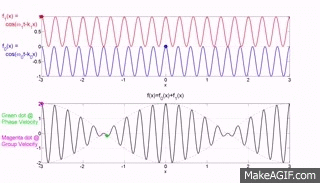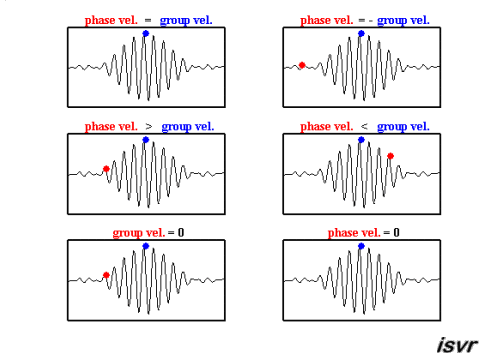How to calculate the phase and group velocity of a superposition of sine waves with different speed and wavelength?
The top two graphs from the MakeaGIF.com website are for waves of one frequency/wavelength travelling at different phase speed as shown by the motion of the red and blue dot sitting on top of a crest.
The term phase is used because you are observing the particle which make up the medium at their maximum upward excursion from the equilibrium position and the speed of that crest is measured as the distance moved by a crest divided by the time taken to move that distance.
You could have equally well chosen to follow a trough or when the particles had zero displacement or the phase $kx-\omega t = \text{constant}$.
Differentiating this expression gives the phase speed as $\left (\dfrac{dx}{dt}\right)_{\rm phase} = \dfrac \omega k$

The bottom graph is the addition of the top two graphs and you will note that a modulating envelope the peak of which as shown by the red dot travels at the group velocity where group refers to the motion of a number (group) of waves added together and $\left (\dfrac{dx}{dt}\right)_{\rm group} = \dfrac {\Delta\omega} {\Delta k}$.
This is derived from French's cosine term where you want the term in the bracket to be a maximum with $\omega = \omega_1-\omega_2$ and $\Delta k = k_1- k_2$ and follow the movement of that maximum.
Hopefully the gif animations below from the Institute of sound and Vibration Research (isvr) will help you to differentiate between group velocity and phase velocity.

The way to get the velocity is exactly the same as given in the link you shared, with some re-interpretations. For the case of a single, travelling sine wave, we demanded the condition that the phase remains constant, i.e., $$kx-\omega t=\text{constant}$$ This implies that $$k\frac{dx}{dt}-\omega=0$$ which gives us the wave velocity Here, we start from the equation, $$y(x,t)=2\text{A }\text{sin}\bigg(\frac{k_1+k_2}{2}x-\frac{\omega_1+\omega_2}{2}t \bigg)\text{cos}\bigg(\frac{k_1-k_2}{2}x-\frac{\omega_1-\omega_2}{2}t \bigg)$$ We can think of this in two ways, $$y(x,t)=\text{C}_1(x,t)\text{ }\text{cos}\bigg(\frac{k_1-k_2}{2}x-\frac{\omega_1-\omega_2}{2}t \bigg)$$ which is the equation of the a travelling wave with angular frequency $(\omega_1-\omega_2)/2$ and wave number $(k_1-k_2)/2$ whose amplitude, instead of being constant, is a function of space and time (For comparison, remember that something similar happens in the case of Bloch functions). In this form, the equation describes the dynamics of the envelope, and absorbs the effects of the ripples within the envelope into the modulation of the amplitude. Now, applying the same condition as before, we get the velocity of the envelope to be, $$v_g=\frac{\omega_1-\omega_2}{k_1-k_2}$$ and we call this the group velocity. Similarly, we could consider the dynamics of the individual ripples while treating the envelope as an amplitude modulation. In this case, we work with $$y(x,t)=\text{C}_2(x,t)\text{ }\text{cos}\bigg(\frac{k_1+k_2}{2}x-\frac{\omega_1+\omega_2}{2}t \bigg)$$ and applying the condition that the phase is constant gives us the velocity of the ripples, which we call the phase velocity, $$v_p=\frac{\omega_1+\omega_2}{k_1+k_2}$$ This kind of separation of slow and fast degrees of freedom is ubiquitous throughout physics.